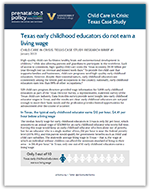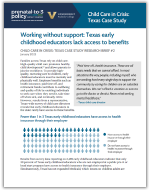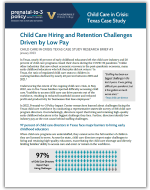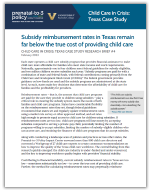States throughout the country are grappling with major issues in early childhood education. Early childhood educators earn wages so low that many cannot afford to remain in the field, but child care programs cannot raise wages without raising tuition, which is already unaffordable for many families. Lack of access to consistent, high-quality child care costs billions of dollars each year through lost tax revenue and missed work days.
In this research brief series, Child Care in Crisis: Texas Case Study, read about national child care issues through original findings from Texas, home to more than 10% of the nation’s children. The briefs explain the specific issues facing the child care industry and what states can do to support early childhood educators and child care businesses, as well as ensure that all families have access to high-quality child care.
In the context of the COVID-19 pandemic straining the child care industry almost to its breaking point, Texas passed House Bill 619. The law tasked the Texas Workforce Commission (TWC) with developing a strategic plan to support the state’s child care workforce. In partnership with TWC, the Prenatal-to-3 Policy Impact Center convened a group of 27 Texas child care experts under the umbrella of the 2022 Texas Child Care Strategic Plan Workgroup (Workgroup), who shared input and recommendations about the needs of the early childhood education workforce in Texas. Simultaneously, more than 800 child care program directors responded to the 2022 Texas Child Care Director Survey, sharing their experiences in the industry, as well as reporting on characteristics and compensation of the early childhood educators at their child care program.
Data from the Texas Director Survey and feedback from the Workgroup guided the development of the Workgroup Recommendations to Inform the 2022 Texas Child Care Workforce Strategic Plan, a comprehensive set of 11 recommendations to stabilize the industry and raise workforce quality. Data collected to develop the recommendations forms the basis of this new research brief series.







